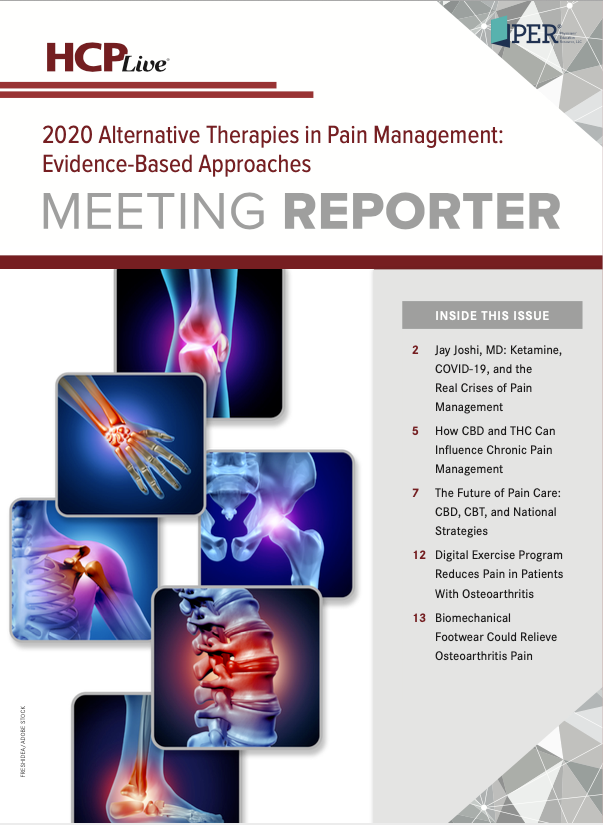Jay Joshi, MD: Ketamine, COVID-19, and the Real Crises of Pain Management
An interview with a pain specialist on advancing alternative pain therapy options.
Jay Joshi, MD

Although it was presented on a virtual platform due to the coronavirus 2019 (COVID-19) pandemic, the interactive CME program “Alternative Therapies in Pain Management: Evidence-Based Approaches” from Physicians’ Education Resources® this November offered clinicians important insights into the growing field of alternative pain care.
The program’s chairs provided views into where pain medicine has been and where it’s headed, from telemedicine to cannabis, from opioid deterrence to ketamine research.
In an interview with HCPLive®, program cochair Jay Joshi, MD, chief executive officer and medical director of National Pain Centers, discussed the program agenda for the program, his own experience with pain management in the COVID-19 era, and current controversial topics in the field.
HCPLive: What do you see as this meeting’s headline discussion?
Joshi: A lot of thought was put into the agenda and specific courses. We wanted to make the courses broad-based, so people who don’t have a lot of experience with pain management will have the opportunity to get some exposure to various types of content. [But] we also wanted to [be sure that] people who do have experience will also find something meaningful and maybe something that they haven’t heard before.
Finally, we wanted to make the course content relevant to 2020, including things like cannabis and COVID, and how we’re approaching this new world, because it has affected everything, including the practice of medicine.
HCPLive: We’ve been burdened by increased demands due to COVID-19, potentially decreasing attention and care to other issues in medicine. What has that looked like for pain management this year?
Joshi: When the lockdown initially occurred, everybody saw fewer patients in person. We’ve been using telemedicine as a platform for more than 3 years, [though,] so for us, it was something we were [familiar with]. We were able to still service patients and their needs, even if it wasn’t in person.
But initially, the procedure count went down substantially for 3 reasons. Number 1, as providers, we were all scared, too. We weren’t sure what we needed to do to stay safe. Fortunately, we procured personal protective equipment at all costs, something that [many] big hospital systems did not do and refused to do because they were trying to save money. We didn’t cut corners. We did whatever it took to maintain our safety and our staff’s safety. Number 2, patients were scared, and many didn’t come in. And number 3, in some areas, state governments had legal mandates that elective procedures were not supposed to be done in certain settings.
HCPLive: Alternative pain medicine is a wide and varied field. Can you highlight a particular agent, drug, or therapy of current interest, heading into the meeting?
Joshi: From the beginning, I’ve always looked at pain management as a multimodal, multidisciplinary specialty. I look at the patient as a whole, [and] although I’m an interventionalist, you have to do that in conjunction with other modalities.
One of the biggest problems with chronic pain is the mental aspect. The physical and the mental, the peripheral [nervous system] and the central [nervous system], are inextricably linked. A lot of my research, and a lot of our first discoveries, have [dealt] with this exact connection, of the peripheral nervous system and the central nervous system.
For example, we were the first in the world to describe a brand-new treatment and a brand-new mechanism for posttraumatic stress disorder (PTSD). The military and a lot of hospitals are basing their treatment for PTSD on our discovery, [which was made] 13 years ago. That’s allowed me to go beyond that discovery to realize other discoveries. We were the first to use ketamine infusions for PTSD, the first to have ketamine infusion at a surgery center as a formal program.
The level of anxiety, depression, and PTSD that’s occurred as a result of the pandemic is massive. So, we’re seeing a lot of people whose pain is increased, maybe [in part] because they’ve become more sedentary. But their pain has [also] increased because their central sensitization has increased. The perception of pain has increased because the brain has fundamentally changed the way that it’s perceiving pain due to the pandemic. So, the treatment or drug that has become incredibly valuable during this epidemic, the thing we use to try to reverse that problem, is ketamine.
HCPLive: Ketamine has really made strides in recent years, not just in academic assessment, but in clinical embrace.
Joshi: I’ve lectured nationally on ketamine infusions. Just a few years back when I was lecturing, people would look at me like I’m crazy, I’m from Mars, just like back in 1999, while I was in medical school, I was the first to predict the Oxycontin epidemic. I’m very used to talking about things way before everyone else.
The problem is that physicians generally don’t understand science. Some of them are interested in understanding it, and they’ll come to conferences like this, to truly understand the science. But most of them look at pain management and pain patients with stereotypes, and they refuse to learn the science. They refuse to learn the theology part of it, the psychology part of it, the cultural part of it. And they approach pain management with massive stereotypes.
So again, conferences like this—obviously, you can’t teach every single thing about every single aspect of medicine—allow science to be presented. And the attendees will hopefully understand more about the scientific basis of pain.
HCPLive: Pain experts have previously told us that pain management and the opioid epidemic are 2 completely separate crises. Would you agree with that?
Joshi: My message has not changed in 20 years, because I was right 20 years ago, I’m right now, and I’ll be right 20 years from now—not because I am right, but because the message is right. Why is the message right? Because it’s built on basic science and basic facts.
What we [have seen with the] opioid epidemic is what we’re seeing with COVID, or anything else: When things get politicized, people make up facts. And then people start polarizing based on whatever their beliefs are. And that’s the fundamental thing: there’s 1 truth.
The fact of the matter is that I have gone around for years, and I’ve yet to see a legitimate patient who’s seeing a legitimate physician being prescribed legitimate, noncounterfeit pain medication, and they’re taking it as prescribed. I have yet, in 20 years, to have seen a single death from an opioid with that criteria. The vast majority of deaths we’ve seen are all related to abuse [and] misuse.
The opioids are not the problem. There is no such thing as the opioid epidemic if people start doing things that aren’t stupid. If people followed directions, and intelligent physicians were doing things correctly, we would not see death. We’ve seen death because the patients weren’t following directions, you had a pill mill, or it wasn’t even prescription opioids.
The chronic pain epidemic and opioid epidemic are completely different.
